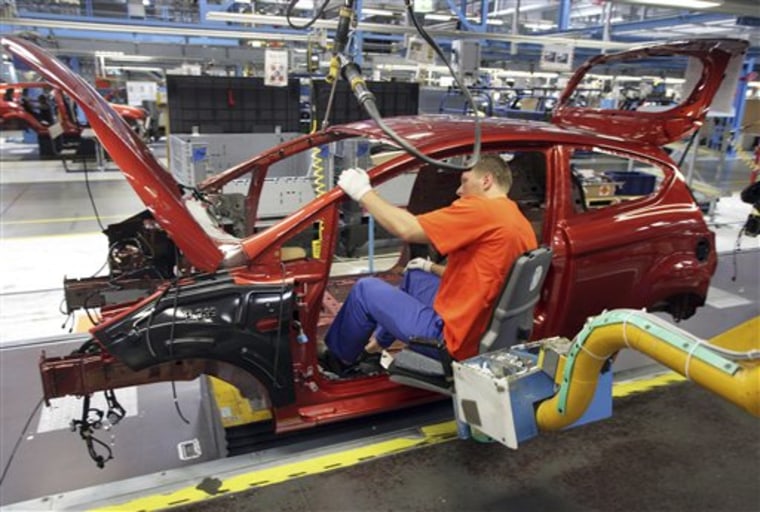It seems like an easy solution: Americans are looking for more fuel-efficient vehicles, so Ford Motor Co. is bringing over some of the small, gas-sipping cars it's been selling to Europeans for years.
But introducing the cars to the U.S. market isn't as simple as changing the speedometer from kilometers to miles. Ford has to reconcile American and European safety regulations — everything from the color of rear turn signals to the positioning of crash test dummies — that will keep the cars from hitting U.S. highways anytime soon.
Competing interests among automakers, governments and the insurance industry are hampering efforts to standardize safety requirements worldwide. That means extra engineering to make different versions of vehicles for different markets.
"Each party negotiating this has their own views about their own standards being better," said Ronald Medford, senior associate administrator of vehicle safety at the National Highway Traffic Safety Administration, which sets U.S. standards. "But as long as we can show we're not lowering safety and we're lowering cost, we're all interested in that."
Some differences are significant, like the U.S. rule that requires protection for passengers not wearing seat belts, which has no European equivalent. Others are small, like the U.S. requirement that vehicles have side lights, which are optional in Europe.
Ford isn't the only automaker facing this issue. The ultra-compact Smart car was sold overseas for nine years, but before Daimler AG could bring it to the U.S., it had to make the car longer to meet U.S. crash standards, spokesman Ken Kettenbeil said.
But Ford's promise to bring six small, fuel-efficient vehicles from Europe and start building them in North America in 2010 puts a new focus on the challenge of satisfying governments' varying requirements.
These global models are the cornerstone of Ford's plan to return to profitability after losing $8.7 billion last quarter. The Dearborn-based automaker says its small European vehicles sell well and are superior to those in the U.S. Ford also plans to save billions from designing products for global sales, boosting profits on small cars, which don't generate the revenue of trucks and SUVs.
Automakers know how to retrofit their vehicles but question the time and expense involved when the changes may not make those vehicles safer, said Jim Vondale, director of Ford's safety office.
"It may involve changes to the structure, it may involve changes to material, but they result in not so many differences in the safety levels of the vehicles," he said.
Ford recently studied 43 regulations in Europe and the U.S. and found that just 11 were equivalent, Vondale said. Fourteen had major differences that would require significant changes. Asian countries' regulations, which are closer to European requirements than their U.S. counterparts, add even more complexities.
It doesn't stop with government standards. Automakers also have to contend with the Arlington, Va.-based Insurance Institute for Highway Safety, which is funded by the insurance industry and runs its own closely watched set of crash tests.
Tests may look similar at the outset but contain crucial differences. The European frontal crash test uses a deformable barrier — made to mimic another car — that slams into 40 percent of the front of the vehicle. That challenges engineers to spread the energy from the crash across the rest of the car. The fixed barrier in the U.S. test absorbs no energy, causing a severe crash that evaluates the vehicle's overall strength.
Adding to the complexity of the frontal test is that the U.S. and Europe put their crash test dummies in different seating positions, which can affect how the air bags should deploy, said IIHS President Adrian Lund.
Some tests have very different goals. IIHS tests bumpers with 3 mph and 6 mph collisions to see how well the bumpers protect the vehicle in a crash. In Europe, tests replicate hitting pedestrians at 25 mph to see how much harm the bumper causes.
"The bumper to absorb energy to reduce the risk of injury is not the kind of bumper system you would design to help protect the vehicle," Vondale said.
Medford said NHTSA's test to make sure cars are safe for unbelted occupants is important in the U.S. market, where people who weren't wearing seat belts make up 45 percent of all traffic fatalities.
"The data that we have really drives the direction and the nature of the standards we develop," he said.
But car makers grumble that NHTSA's requirement makes cars less safe for belted occupants, since protecting people without seat belts requires more powerful air bags and other changes.
"We would much prefer to design a vehicle that provides good protection for unbelted occupants but is tuned specifically to protect occupants that are doing what they're supposed to be doing," Vondale said.
He said 40 countries, including the U.S., have signed on to a 10-year-old effort to harmonize regulations. The group has agreed to frameworks for global regulations governing door locks, rear head restraints and electronic stability control. Next, the group will consider pedestrian protection.
But efforts to match lighting standards, for example, were shelved after Japan nixed a regulation requiring daytime running lights and Europe refused to allow rear turn signals to blink red instead of amber, Vondale said.
"It's very difficult for governments that have had a specific regulation on their books for many years to suddenly decide to change," Vondale said. But he said the short-term cost of redesigning vehicles for the global market would be more than made up by the long-term savings of harmonization.
"We think it's very important to have a single set of requirements that can be enacted globally," he said.
